Garlic Mustard Seeds
By Mike on Saturday, July 20, 2013, 07:56 - Permalink
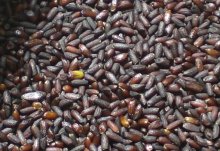 I've already given this plant (Garlic Mustard) two chances as a wild vegetable - and found it disappointing. Let's have one more go.
I've already given this plant (Garlic Mustard) two chances as a wild vegetable - and found it disappointing. Let's have one more go.
But this time, instead of the leaves, I'm going to try eating the ripe seeds.
Garlic Mustard Seeds
We've had a few weeks of very hot dry weather and the plants of Garlic Mustard are transformed to gaunt, straw-coloured branched upright sticks.
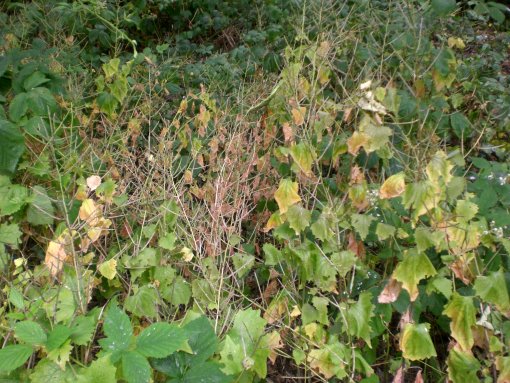
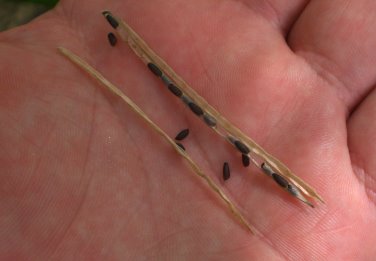 The branched structures are actually slender seed pods - each containing about a dozen cylindrical brown/black seeds.
The branched structures are actually slender seed pods - each containing about a dozen cylindrical brown/black seeds.
The pods split open easily at the slightest touch once ripe - I found that the best way to harvest the seeds without losing too many is to crush and massage the whole plant and its pods and allow everything to fall into a large plastic container below.
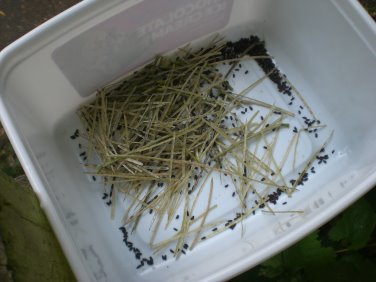 A little more crushing and rubbing by hand released most of the remaining seeds from the pods.
A little more crushing and rubbing by hand released most of the remaining seeds from the pods.
It was then possible to winnow away the pods by gently blowing into the container.
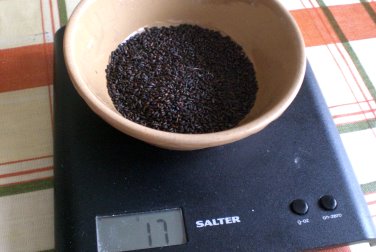 I collected what I considered an adequate quantity of seed for experimentation.
I collected what I considered an adequate quantity of seed for experimentation.
Once cleaned, this weighed in at 17g of seed, but they need fully drying before anything else.
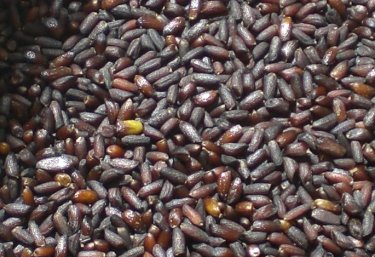 The plan is: dry the seeds fully, grind them with a granite pestle and mortar, then blend them with water and a little vinegar to make a condiment.
The plan is: dry the seeds fully, grind them with a granite pestle and mortar, then blend them with water and a little vinegar to make a condiment.
This is, after all, a mustard plant, and these are mustard seeds - so let's see if we can make mustard...
 After 24 hours on a sunny windowsill, the seeds had shrunk a little, hardened and turned uniformly dark brown.
After 24 hours on a sunny windowsill, the seeds had shrunk a little, hardened and turned uniformly dark brown.
They had also lost a few grammes as they dried - equivalent to about 17% of their original weight - this was what I hoped for and expected, as dry seeds would be easier to grind.
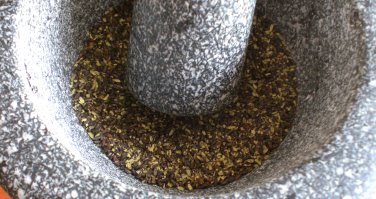 I ground the seeds to a coarse powder using my granite pestle and mortar. At this stage, they gave off a rather unpromising grassy, earthy aroma, but I kept going.
I ground the seeds to a coarse powder using my granite pestle and mortar. At this stage, they gave off a rather unpromising grassy, earthy aroma, but I kept going.
Dividing the batch into smaller portions (about 1 or 2 teaspoons full) made it easier to grind to a finer texture.
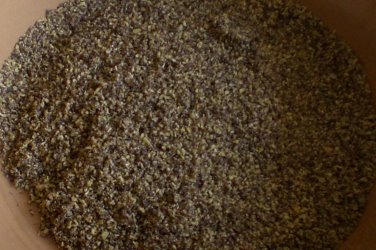 The resulting mustard powder looked a little like ground black pepper - I probably could have achieved a finer grind either just by working longer, or perhaps by wet-grinding - that is, performing the mixing steps (next) with the mortar and pestle.
The resulting mustard powder looked a little like ground black pepper - I probably could have achieved a finer grind either just by working longer, or perhaps by wet-grinding - that is, performing the mixing steps (next) with the mortar and pestle.
But I quite like wholegrain, coarse-textured mustard, so I left it like this.
 To make the mustard, I first measured the amount of my ground seeds (6 heaped teaspoons) - to this, I added two teaspoons of cider vinegar, about a quarter of a teaspoon of salt and enough ice cold water to make the mixture into a paste of approximately the expected consistency.
To make the mustard, I first measured the amount of my ground seeds (6 heaped teaspoons) - to this, I added two teaspoons of cider vinegar, about a quarter of a teaspoon of salt and enough ice cold water to make the mixture into a paste of approximately the expected consistency.
The seeds were darker than ordinary mustard seeds (which are golden yellow or tan), so my Hedge Garlic Mustard is quite dark when mixed.
Mustard really is a strange thing to make - see below for more details.
Hedge Garlic Mustard
There was enough mustard mix to just fill a tiny jar, with a little left over in a little dish - I put this all in the fridge and left it for a couple of hours before tasting.
I spread some on top of some little pieces of mature cheddar on thin crackers.
The result was interesting, delicious - definitely recognisable as mustard, moderately, but pleasantly pungent, but with an amazing nutty, earthy aroma. I have never tasted anything quite like it.
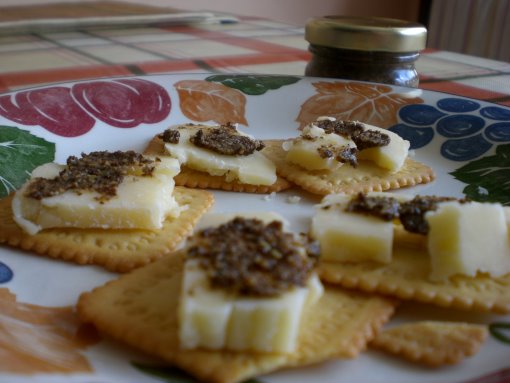
At Last!
So at long last, I've managed to make something not only edible, but delicious, from this stubborn plant!
I'll taste it again after 12 and 24 hours from when it was first made - and report the results here, but even at this stage, I'm calling this a resounding success.
Update
After 12 hours, the mustard had developed more heat (as expected).
24 hours after initial mixing, the flavour is really quite excellent - good and hot, but not harsh or searingly eye-watering - the flavour is now very nicely balanced - still very deep and complex with nutty and earthy notes, but also with a bright, horseradish-like freshness. I am absolutely delighted with this amazing, tasty condiment!
The only things I might do differently next time: grind either much finer, or a little coarser - the texture is not unpleasant, but it's neither smooth nor coarse.
I'd also add a little more liquid to the mix. during the initial 24 hours development, it thickened to a dryish paste (this must just have been absorption into the grounds, as it happened inside the sealed jar) - this was easy to adjust afterwards with just a little more water/vinegar, but if I was making this mustard to give away, I'd add more liquid, so as to make it ready to use immediately on opening.
Mustard Theory
More like chemistry than cooking, the process of making mustard is quite a strange one that requires care and consideration.
When the ground mustard is mixed to a paste, compounds from the mustard seed react with each other and the water, but this takes time to happen, so freshly-mixed mustard is relatively tasteless and usually lacks any of the heat and pungency normally associated with the condiment.
Over the course of a few hours though, the mixture develops the classic mustard flavours - and as quickly as it arrives, it may also disappear - the very best mustard is made from freshly-ground seeds, in small batches.
Making it with hot water may prevent this from ever happening - resulting in a mild flavoured mustard (this is why I used cold water) - the addition of vinegar also helps to develop and preserve the heat and aroma.
Video
Here's a video (added 27th July 2016) of the process of making mustard condiment from these seeds:
Note
Before, during or after the video(s) embedded in this page, the player may display advertisements or links to additional videos - these are not affiliated to Atomic Shrimp and the selection is something over which I have no control.
